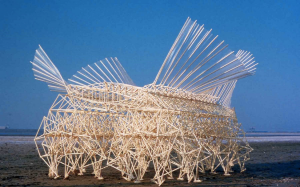Matt Armo
ARST 250
Prof. Meiser
1/29/17
Theo Jansen, Strandbeest (Animaris Currens Ventosa)
Immediate Response
The intricacy of the piece immediately stands out to me. It is made of many sections of a PVC pipe material that includes a bunch of feet, a central body, and what appear to be wings. The “animal” seems complex and able to move fluidly much like a human. The object does not bounce while traveling and is able to keep level. This must require precision tolerance of each leg, to ensure the kinetic sculpture won’t move up and down during translational movement. The piece appears very lifelike and moves kind of like an insect with its many legs and two wings.
Objective Description
I see many pieces of PVC piping all zip tied and connected into a sort of structure and lattice. There look to be about 10 legs that each have 5 feet that are able to move and rotate by stepping on the ground to advance the beast and keep it stable and moving forward. There is an arc of pipes on the top to form the back of the animal which is smooth and flat. There are also two long wings on each side that stretch down the entire length of the body and can capture energy out of the wind and allow the piece to move. These wings have PVC supports running through them like bones to give structure and strength to the wings.
Technical Decisions
The artist describes trying to create a new form of life through these animals and he thinks that they will soon be basically independent. The work was made meticulously and with much thought and looks great as an entire piece but was made with limited materials which leads to sloppy looking joints under close inspection. The way the art is presented is that it is released into the world and onto beaches in the Netherlands. The animal is made of inexpensive piping because of its ease of workability, abundance, and cost. The piece is visually appealing to watch and it also leaves lots of room for improvement, which Theo is working hard to implement to make these animals more lifelike.
The Work in the World
This artwork is unique. It combines both art and engineering into one. I could see it combining even more subjects, like biology, and animal behavior because of how lifelike they may become with different technologies. Theo really believes in how alive these sculptures are and delves into their brain and adaptive mechanism systems which run off of the wind. Each animal created is given a species and genus name, like any real living animal found in the wild, which goes to solidify how alive Theo and some others perceive these animals to be. I would compare it to artificial intelligence in a way. Artwork can integrate artificial intelligence and even non-art related AI can be compared to how creators want to see their creations evolve.
The Story it Tells
AI is man’s way of replicating human consciousness using electricity, wires, and circuit boards, much like Theo tries to recreate life and movement in animals, using piping, zip ties, and pressurized bottles. As much as manmade items can appear to mimic life, it is difficult to fully mimic all aspects of movement and consciousness. Theo is trying to create a primitive form of life that might not coincide with all of biology’s definitions of life, but might be able to exist and move independently. This definition of life includes movement, and the knowledge of survival mechanisms, like moving away from water to prevent drowning and anchoring itself in heavy winds.
